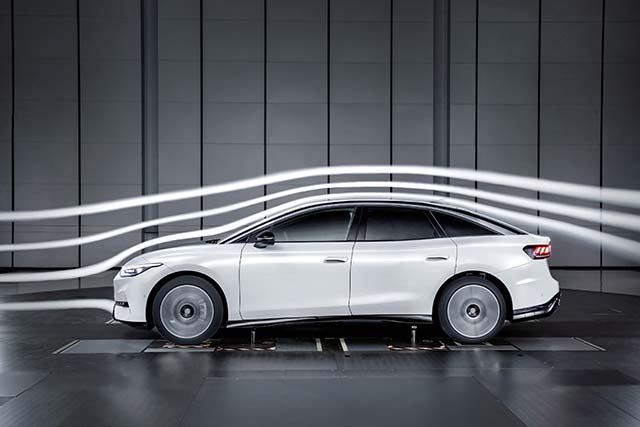Volkswagen has unveiled its first electric vehicle for the upper mid-sized class, the ID.7, marking a significant step in the company’s electric vehicle lineup. Boasting an impressive range of up to 700 kilometers according to WLTP standards, the Volkswagen limousine sets a new standard for efficiency in its segment. The extended range of the ID.7 can be attributed not only to its advanced drive system but also to its sophisticated aerodynamics, which have been meticulously developed through close collaboration between the Design and Development departments.
Aerodynamic performance plays a crucial role in the efficiency of vehicles, with the body shape alone accounting for approximately 50 percent of the overall drag coefficient (Cd value) of a limousine like the ID.7. The wheels and tires influence about 30 percent, while the underfloor and functional openings, which facilitate air flow to the radiators at the vehicle’s front end, contribute 10 percent each. The ID.7 demonstrates Volkswagen’s commitment to aerodynamic excellence, as evidenced by its sleek silhouette and careful attention to design details. The vehicle’s nearly five-meter length showcases its low front end, seamless transition into the bonnet, and streamlined windshield. The coupé-like roof design and tapered rear end further enhance its aerodynamic performance.
To achieve optimal results, Volkswagen’s developers and designers worked meticulously on various aspects of the ID.7, including the exterior design, underbody, wheels, and other fine details. The collaborative efforts between these teams allowed for an iterative process that incorporated computer simulations and wind tunnel tests to fine-tune the vehicle’s aerodynamics.
Several key aerodynamic features contribute to the ID.7’s impressive performance. The vehicle features an almost completely closed underbody, supplemented by newly developed wheel spoilers on the front wheels. These spoilers guide the air along the wheels, minimizing turbulence under the vehicle. Air curtains positioned at the sides of the front bumper direct airflow around the front end with minimal loss. The flared side sills prevent air from flowing into the underbody area and shield the rear tires from unwanted airflow. Additionally, small spoilers and trim panels on the underbody guide the airflow.
Recognizing the significant impact of wheels on aerodynamics, the Volkswagen team focused particular attention on optimizing wheel design. The wheel rims were carefully designed to prioritize aerodynamics while also meeting the cooling requirements of the brakes. The resulting wheel rims feature a more closed design, offering exceptional aerodynamic properties. Flow simulations were also employed to fine-tune the tire contours, allowing for optimization of variants with less favorable aerodynamic characteristics during the concept phase.
The holistic aerodynamic development process encompassed various other areas as well. Functional openings at the front of the vehicle, through which air flows to the radiators, are actively controlled by a radiator roller blind in the ID.7. This feature helps reduce drag by opening only when targeted cooling of the power units and battery is necessary. At the rear, aerodynamic efficiency is ensured through the ideally shaped tailgate, diffuser, and side separation edges.
The initial stage of development heavily relied on computer simulations, which were conducted regularly over the course of the first year. The design team provided CAD data, and several thousand processors calculated airflow values, including details such as flush-recessed door handles and aerodynamically designed mirrors. Wind tunnel testing was reserved for later stages when the design was stable, which typically occurred after about one and a half years of development.
In the wind tunnel, Volkswagen utilized clay models of the ID.7 in its original size. The team made precise adjustments, such as modifications to the rear and separation edges, using a milling cutter. 3D-printed prototype parts were employed to test numerous variants, including aerodynamically shaped exterior mirrors. This meticulous process allowed the team to optimize the upper and lower mirror housing sections and mirror base, achieving a lower drag coefficient and exceptional aerodynamic properties. As a result, the ID.7 boasts an impressive Cd value of 0.23, the best in the entire Volkswagen ID. family.
